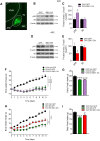mTOR signaling in the arcuate nucleus of the hypothalamus mediates the anorectic action of estradiol
- PMID: 29914932
- PMCID: PMC6055430
- DOI: 10.1530/JOE-18-0190
mTOR signaling in the arcuate nucleus of the hypothalamus mediates the anorectic action of estradiol
Abstract
Current evidence suggests that estradiol (E2), the main ovarian steroid, modulates energy balance by regulating both feeding and energy expenditure at the central level, through the energy sensor AMP-activated protein kinase (AMPK). We hypothesized that the hypothalamic mechanistic target of rapamycin (mTOR) pathway, a well-established nutrient sensor and modulator of appetite and puberty, could also mediate the anorectic effect of E2. Our data showed that ovariectomy (OVX) elicited a marked downregulation of the mTOR signaling in the arcuate nucleus of the hypothalamus (ARC), an effect that was reversed by either E2 replacement or central estrogen receptor alpha (ERα) agonism. The significance of this molecular signaling was given by the genetic inactivation of S6 kinase B1 (S6K1, a key downstream mTOR effector) in the ARC, which prevented the E2-induced hypophagia and weight loss. Overall, these data indicate that E2 induces hypophagia through modulation of mTOR pathway in the ARC.
Keywords: estradiol; food intake; hypothalamus; mTOR; obesity.
© 2018 The authors.
Figures





Similar articles
-
Hypothalamic mTOR signaling mediates the orexigenic action of ghrelin.PLoS One. 2012;7(10):e46923. doi: 10.1371/journal.pone.0046923. Epub 2012 Oct 9. PLoS One. 2012. PMID: 23056530 Free PMC article.
-
Anorectic estrogen mimics leptin's effect on the rewiring of melanocortin cells and Stat3 signaling in obese animals.Nat Med. 2007 Jan;13(1):89-94. doi: 10.1038/nm1525. Epub 2006 Dec 31. Nat Med. 2007. PMID: 17195839
-
Estradiol acts in the medial preoptic area, arcuate nucleus, and dorsal raphe nucleus to reduce food intake in ovariectomized rats.Horm Behav. 2011 Jun;60(1):86-93. doi: 10.1016/j.yhbeh.2011.03.009. Epub 2011 Apr 1. Horm Behav. 2011. PMID: 21439964 Free PMC article.
-
The role of the mTOR pathway in regulating food intake.Curr Opin Drug Discov Devel. 2010 Sep;13(5):604-12. Curr Opin Drug Discov Devel. 2010. PMID: 20812152 Review.
-
Hypothalamic roles of mTOR complex I: integration of nutrient and hormone signals to regulate energy homeostasis.Am J Physiol Endocrinol Metab. 2016 Jun 1;310(11):E994-E1002. doi: 10.1152/ajpendo.00121.2016. Epub 2016 May 10. Am J Physiol Endocrinol Metab. 2016. PMID: 27166282 Free PMC article. Review.
Cited by
-
Roles of estrogens, estrogen-like compounds, and endocrine disruptors in adipocytes.Front Endocrinol (Lausanne). 2022 Sep 21;13:921504. doi: 10.3389/fendo.2022.921504. eCollection 2022. Front Endocrinol (Lausanne). 2022. PMID: 36213285 Free PMC article. Review.
-
Kappa-Opioid Receptor Blockade Ameliorates Obesity Caused by Estrogen Withdrawal via Promotion of Energy Expenditure through mTOR Pathway.Int J Mol Sci. 2022 Mar 14;23(6):3118. doi: 10.3390/ijms23063118. Int J Mol Sci. 2022. PMID: 35328539 Free PMC article.
-
Tamoxifen Blocks the Development of Motivational Features of an Addiction-Like Phenotype in Female Rats.Front Behav Neurosci. 2019 Nov 8;13:253. doi: 10.3389/fnbeh.2019.00253. eCollection 2019. Front Behav Neurosci. 2019. PMID: 31780909 Free PMC article.
-
Estradiol and appetite: To eat or not to eat.Mol Metab. 2020 Dec;42:101061. doi: 10.1016/j.molmet.2020.101061. Epub 2020 Aug 6. Mol Metab. 2020. PMID: 32771697 Free PMC article. No abstract available.
-
Crosstalk between Melanin Concentrating Hormone and Endocrine Factors: Implications for Obesity.Int J Mol Sci. 2022 Feb 23;23(5):2436. doi: 10.3390/ijms23052436. Int J Mol Sci. 2022. PMID: 35269579 Free PMC article. Review.
References
Publication types
MeSH terms
Substances
LinkOut - more resources
Full Text Sources
Other Literature Sources
Miscellaneous

